South Africa is an incredible country with a wide range of climates, people, and animals, so it’s no surprise its national flower is the astonishing king protea. With a name like that, you know it’s going to be good! Let’s discover the national flower of South Africa: the king protea and why it symbolizes the South African nation so well.
What is the National Flower of South Africa?
The national flower of South Africa: the king protea is also called the sugarbush or the cape artichoke flower.
The Proteaceae family is one of the oldest flowering plant families on the planet. Fossils show they grew 300 million years ago! Today there are 360 species of protea, but king protea (Protea cynaroides) was chosen to be South Africa’s national flower.

The Proteaceae family is one of the oldest flowering plant families on the planet. Fossils show they grew 300 million years ago!
©Jan Combrinck/Shutterstock.com
Where is South Africa?
The Republic of South Africa is situated at the southern end of the African continent. It borders Botswana, Zimbabwe, and Namibia and has 2798 kilometers of South Atlantic and Indian Ocean coastline along its southernmost point. It’s this southernmost location that gives rise to its name South Africa.
South Africa is home to 60 million people and covers 1,221,037 square kilometers of high plateaus, rolling grasslands, mountains, and plains. There are three capital cities Pretoria, Bloemfontein, and Cape Town.
This country has some of the oldest human fossil remains in the world. Archaeologists have dubbed caves in the Gauteng province “the cradle of civilization” and those caves are now a UNESCO world heritage site. With such an extensive fossil record, it’s no wonder the 300 million-year-old protea species is the national flower of South Africa.

The Republic of South Africa is situated at the southern end of the African continent.
©Wead/Shutterstock.com
Why is the King Protea South Africa’s National Flower?
King protea was chosen because not only is it the largest and most stunning of the protea flowers, it’s tough and adaptable. King protea bushes regenerate from intense wildfires and cope with long-term drought, so it’s a symbol for South Africa’s resilience, national values, and culture.
Proteas represents change and hope in the African tradition, and in Europe’s flower language they stand for diversity and culture. South Africa’s motto is Diverse People Unite, so the king protea flower truly symbolizes their national spirit.
The king protea is one of the most stunning proteas and it’s emblazoned on many South African products to identify them without writing a word. South Africans also call their cricket team The Proteas!
A Short History of Proteas
Proteas are a genus of flowering plants native to South Africa. The genus Proteoideae was named by the famous botanist Carl Linnaeus in 1735. He named it after the shape-shifting Greek god Proteus, the son of Poseidon, because there are so many different proteas. Today the list stands at 360 different protea species!
The majority of proteas grow in a coastal belt of montane land stretching from Clanwilliam to Grahamstown just south of the Limpopo river. Mount Kenya National Park is also home to some species of protea. This geographical area is called the Cape Floristic Region (Cape fynbos) and is one of the world’s biodiversity hotspots.
In the 17th century visiting botanists noticed protea flowers at the Cape of Good Hope and brought them back to Europe in the 18th century. This is why they grow in countries outside of their native South Africa.
King protea: Flowers
King protea flowers are incredible, they look like alien flowers from another dimension!
When the first emerge, they grow in a cone-like head and burst into a circular plate of yellow and red centered flowers surrounded by stiff pink-tipped outer bracts. Each flower can reach 12 inches across and the shrub will produce many at the same time.
It’s called the king protea because the flowerhead resembles a crown!
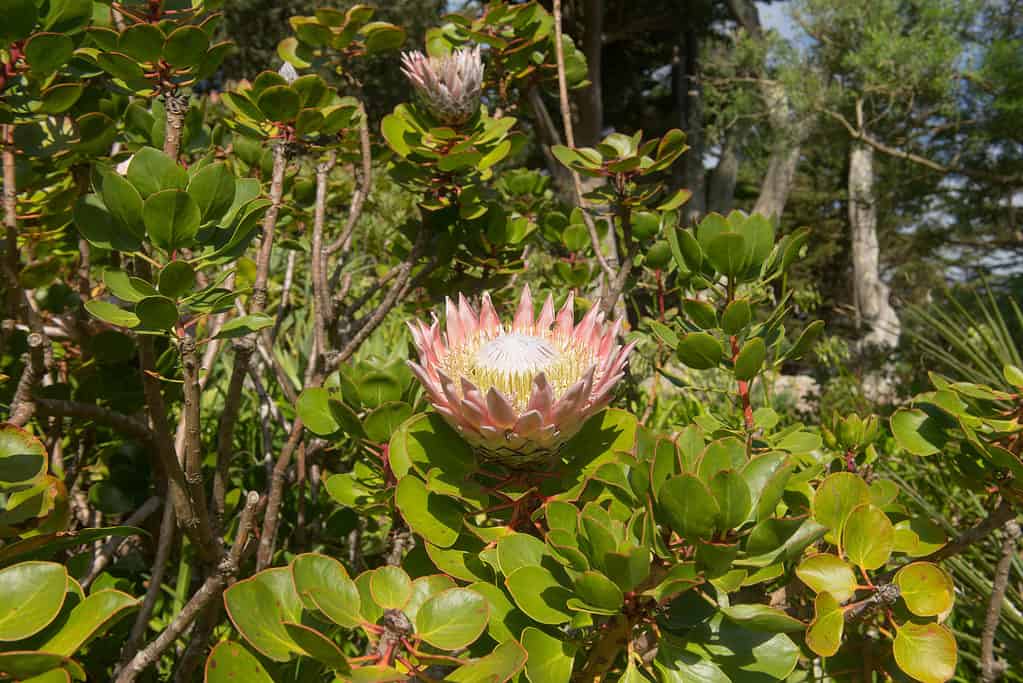
The leaves are distinctive, so king protea is easy to locate even without its spectacular flower heads in bloom.
©Peter Turner Photography/Shutterstock.com
King protea: Foliage
Protea cynaroides is an evergreen shrub with few branches and spoon-shaped leathery elliptic leaves. The leaves are distinctive, so king protea is easy to locate even without its spectacular flower heads in bloom.
It’s foliage sprouts rapidly after wildfires, and this quickness to recover is one of the reasons why king protea is the national flower of South Africa.
Height and Spread of King Protea Shrubs
Wild king protea shrubs reach around four to five feet in height and spread.
What Animals Eat King Protea Plants?
South Africa has a diverse range of animals, so it’s not surprising that a whole host of them take advantage of king protea.
Sugarbirds and sunbirds drink its abundant nectar, while insect-eating birds and dragonflies use their broad branches and tough flower heads as perches. Inside the flowerheads many different species of insects take cover, caterpillars each the foliage, and wild baboons pick out the seeds.
It’s sunbirds and sugarbirds that usually pollinate king protea shrubs, but insects, and rodents looking for an insect dinner, also spread its pollen.
One of the most prolific protea insects is the trichostetha fascicularis beetle. This little beetle only lives in protea flowerheads and scientists have found up to 2000 of them in one bloom!
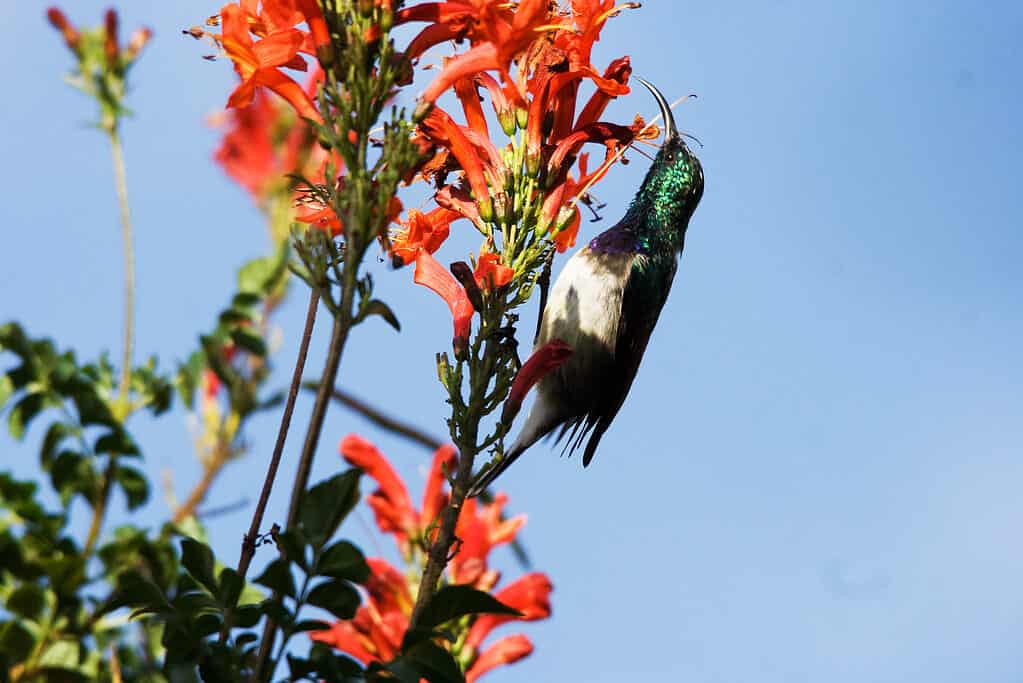
Sunbirds enjoy drinking the nectar.
©iStock.com/kobuspeche
South Africa’s National Symbols
King protea is the national flower, but South Africa has many other symbols too.
The real yellowwood is its national tree, and its national bird is the stunning blue crane. Galjoen is South Africa’s national fish and the national animal is its native springbuck.
The incredible array of fauna and flora really highlight what an important diversity hotspot South Africa is.
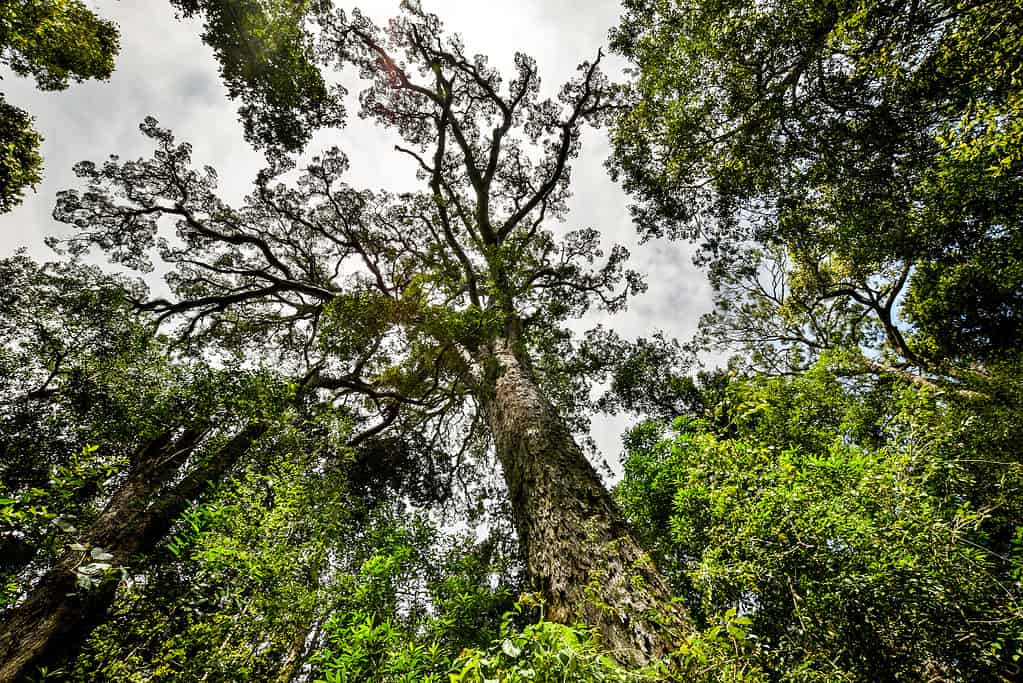
The real yellowwood is iSouth Africa’s national tree.
©iStock.com/wallix
Can You Grow Proteas at Home?
Yes, you can grow king proteas at home.
King proteas (and all species of protea) are not hardy, they need heat and sunshine to thrive. This means they grow well in New Zealand, Australia and USDA zones 9-12 such as southern California. King protea is a fantastic conservatory plant in the UK and northern Europe.
King proteas need:
Sun and more sun
At least eight hours of direct sunshine a day is required to keep king proteas in tip-top health. They just won’t flower in shade or even partial shade.
Lots of air circulation
King protea likes a dry life! If its foliage is constantly damp it’ll grow fungus and rot. Ensure there’s plenty of air movement e.g. don’t plant them close together.
Well drained soil
Choose a rocky unused area. King protea’s roots grow horizontally, so sitting water will rot their roots and quickly kill the whole shrub.
Mix bark, grit, or even Styrofoam (best in containers) into the soil to provide great drainage.
Water infrequently and don’t fertilize them
King proteas only need water every two to three weeks (weekly when new plants are establishing) and they don’t need fertilizer.
Other Proteas Native to South Africa
On our journey to discover South Africa national flower: the king protea we’ve uncovered some incredible facts, but South Africa is also home to other amazing proteas from shrubs to 25 feet tall trees. Let’s take a look!
Pincushion protea (Leucospermum cordifolium)
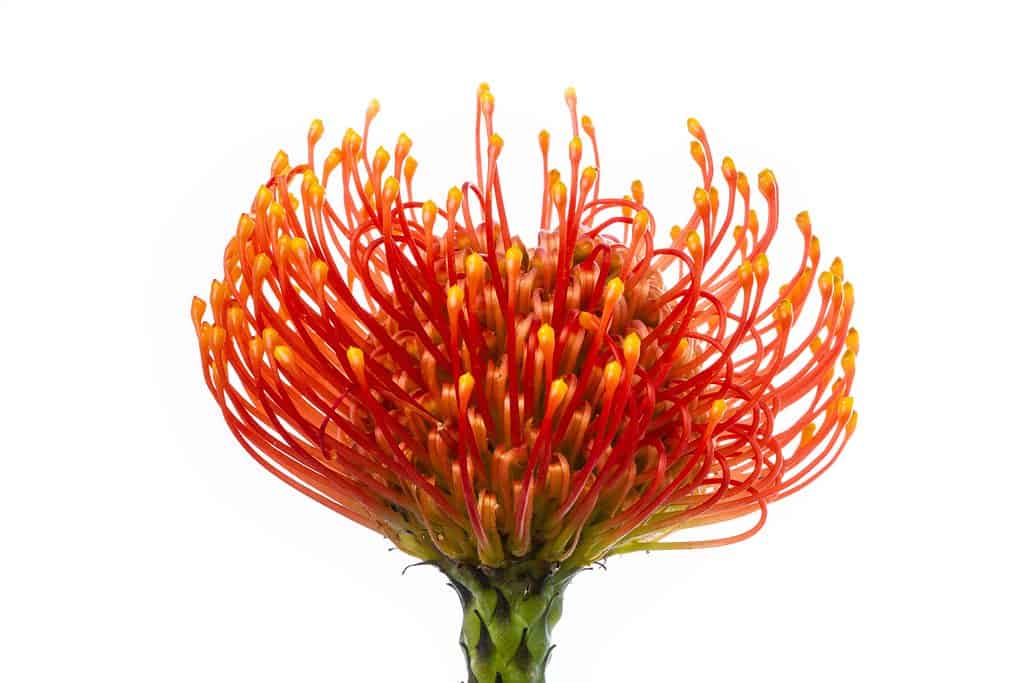
It’s called the pincushion because it’s styles are long, emerging from the flowerhead like pins.
©Dmitri Gomon/Shutterstock.com
This is a spreading evergreen protea with stalkless leaves and arching stems that hold its huge flower heads. Pincushion protea’s orange, red, or yellow flowers measure up to six inches in diameter.
It’s called the pincushion because it’s styles are long, emerging from the flowerhead like pins. They wave in the breeze to attract pollinators.
Skyrocket protea (eucospermum reflexum)
With its upward facing leaves, it’s easy to see why this protea is the skyrocket.
It grows from a single trunk, has small gray-green leaves and stunning vivid flowerheads that are usually dark orange. In Afrikaans its called perdekop “horse’s head” and flowers from August to December.
Skyrocket protea is endemic to southwest South Africa.

Called the limestone protea because it grows in South Africa’s limestone hills.
©Gurcharan Singh/Shutterstock.com
Limestone sugarbush (Protea obtusifolia)
Called the limestone protea because it grows in South Africa’s limestone hills, this vivid protea is a shrub that reaches 10-15 feet tall with lance-shaped gray-green hairy leaves.
Its flowers pointed upwards with a circle of protective dark pink bracts guarding its pale inner petals like a goblet.
This protea is classed as near threatened in the wild due to invasive plants in its limestone environment. Experts estimate 25% have been lost.
Protea longifolia
Our final protea of South Africa is the long-leafed protea. It’s a fynbos shrub that reaches 3-4 feet tall and up to eight feet wide. Its gray-green leathery leaves are curved with a single twist.
This protea has typical stunning flowers of the genus. It has a single central pointed cone of black hairs and opens into a purple-gray and white goblet-shaped bloom.
Protea longiflora is classed as vulnerable in the wild due to habitat loss and over-harvesting.
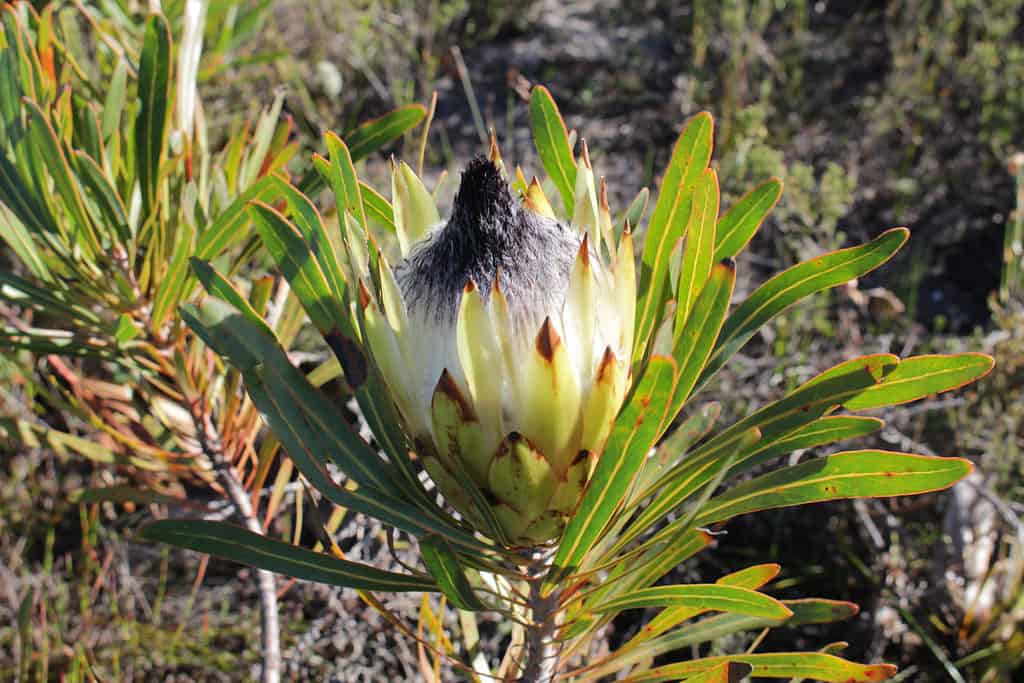
Protea longiflora is classed as vulnerable in the wild due to habitat loss and over-harvesting.
©Maria Art/Shutterstock.com
Up Next
- 7 Incredible Trees Native to New Zealand
- Watch An Absolute Unit of A Great White Leap From the Ocean in South Africa
- 18 Gorgeous Flowers Native to the Phillipines
The photo featured at the top of this post is © Hesti Lestari/Shutterstock.com
FAQs (Frequently Asked Questions)
Why is the proteaceae family so special?
The Proteaceae family is one of the oldest flowering plant families on the planet. Fossils show they grew 300 million years ago! Today there are 360 species of protea, but king protea (Protea cynaroides) was chosen to be South Africa’s national flower.
Where can one grow king protea?
King proteas (and all species of protea) are not hardy, they need heat and sunshine to thrive. This means they grow well in New Zealand, Australia and USDA zones 9-12 such as southern California.
Thank you for reading! Have some feedback for us? Contact the AZ Animals editorial team.







